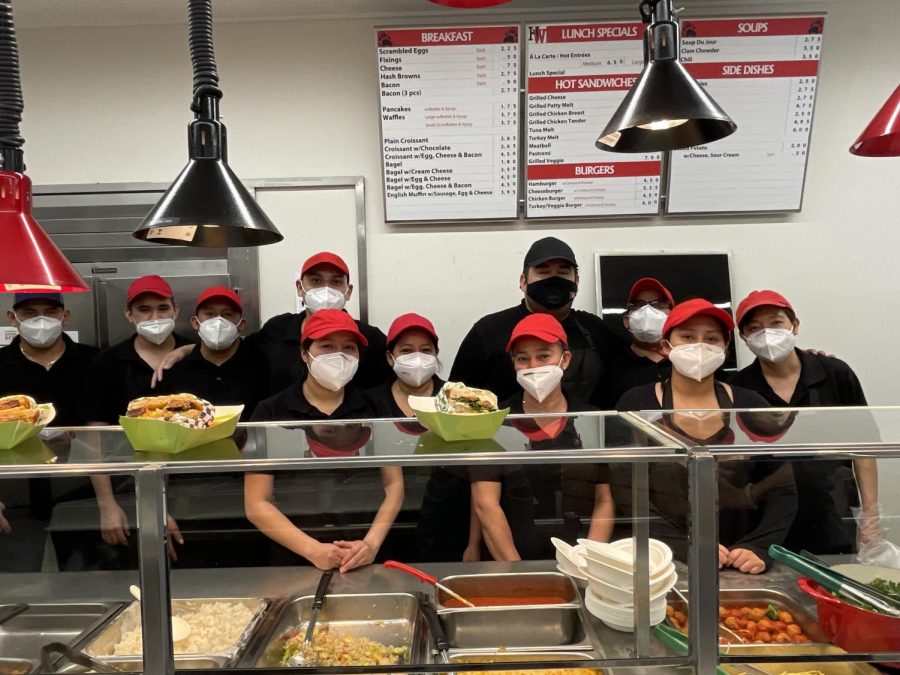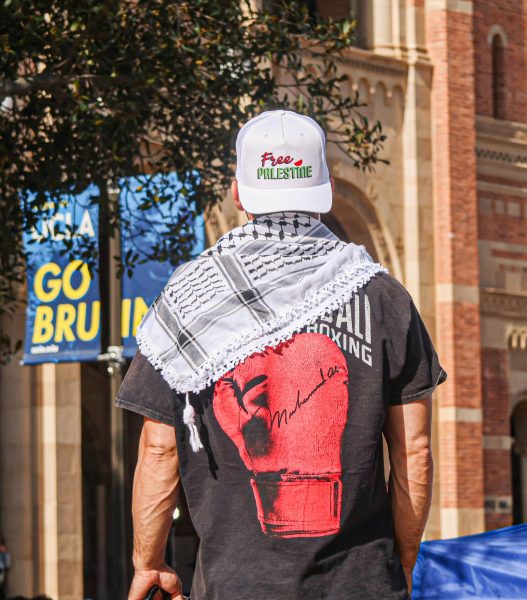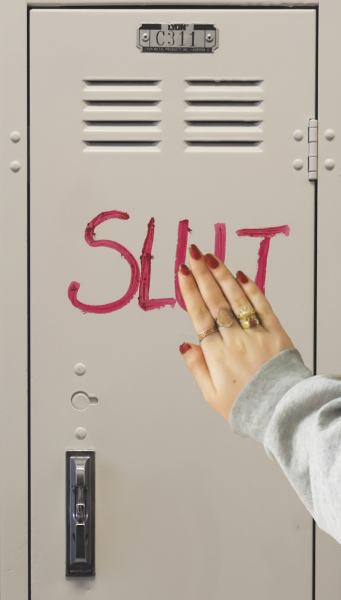All in a day’s work
Cafeteria workers outline their daily lives working at the school and cooking hundreds of meals while interacting with students.
The cafeteria staff stands smiling for a photo in front of the food.
March 28, 2022
Campus is quiet when the sun begins to peak over the Studio City hills; the sprinklers are just turning off as Cafeteria Chef Oswald Monge begins his work for the next ten hours. Until 4 p.m., Monge and 27 other cafeteria staff members will serve spaghetti and meatballs to over a thousand students, teachers and administrators. In addition to the different hot meals served each day, the cafeteria sells fruit, drinks and snacks and provides a salad and sandwich bar.
“It has been great to be able to have worked here the past five years,” Monge said. “The environment is super nice. I really love to cook and being able to do that all day is just what I want.”
Monge said he personally cooks around 300 meals per day and that he and the rest of the staff have must work together to handle their long shifts.
“We get there at [6 a.m. in] the morning, and we help each other,” Monge said. “Whatever we need to get done, it gets done [with us working] as a whole team.”
Monge and the rest of the cafeteria staff are overseen by Cafeteria Manager Nipa Boonyamas, who began working at the school immediately after graduating from high school in 1993. Boonyamas said she took over the cafeteria operation in 2008 following the death of Thiak Lor, who had worked at the school for 25 years.
When she took over as Cafeteria Manager, Boonyamas founded Healthy Choice Catering Corporation to replace Thiak Lor Food Service, the company that hired employees, ordered raw ingredients and prepared meals before. Healthy Choice runs both the upper school and middle school cafeterias.
According to the school’s tax filings, the school paid $3.4 million to Healthy Choice during the 2019-2020 school year. For comparison, the school paid $3.1 million for security and janitorial services and $1.7 million for student transportation that same school year. Since 2008, the school has paid Healthy Choice a total of $32.5 million, according to the filings.
Chief Financial Officer David Weil ’93 said the money the school pays Healthy Choice is a sum of the purchases students, faculty and staff make in both cafeterias. Payments are recorded using Didax, the school’s data management software; the school then takes the money from students’ accounts to pay Healthy Choice.
“Purchases [made by students] comprise more than two-thirds of all payments made to Healthy Choice and are a direct pass-through from the school,” Weil wrote in an email. “In other words, the purchases are tallied by the school and, periodically, payment is made to Healthy Choice. There is no markup whatsoever by the school.”
Weil said around 20% of the school’s payments to Healthy Choice are for employee purchases at the cafeterias, which the school provides allowances for. The remainder goes paying Healthy Choice to cater for events like graduation and parent receptions. Boonyamas and her team provide food preparation, cooking and service for all such events.
“[The school] provides this employee allowance in recognition of the fact that it isn’t always feasible, particularly for teachers, to leave campus during the school day.” Weil wrote. “Funding for this category of expenses comes from the operating budget. The last category [of payments to Healthy Choice] consists of all the events we host throughout the year. ”
Weil said the school works with Healthy Choice to find balance for customers.
“Our goals with Healthy Choice have always been to provide nutritious food, a varied menu in which hopefully everyone can find something to like at a reasonable price point,” Weil said in an email. “We recognize that those goals are sometimes at tension with each other, but [we] do our best to find the right balance to satisfy the greatest portion of our community.”
On a typical day, Boonyamas said the cafeteria produces and sells 60 pounds of bacon, 60 pounds of chicken strips, 60 pounds of French fries, 60 pounds of grilled chicken and 100 pounds of white rice. A hundred breakfast burritos are made and sold each day, making them the most popular item in the morning; tacos, orange chicken and burgers are popular for lunch.
“The number one item is always the breakfast burrito,” Boonyamas said. “Especially nowadays after [COVID-19], students like items that are grab-and-go.”
In lieu of recent worldwide inflation, Boonyamas said it has become difficult to maintain reasonable prices. She said she will continue to run a break-even operation and cover the difference in rising prices because students with financial aid are given a limited amount of money to spend with their allowances each year.
“We have to cover the change in prices [that happen] because of inflation,” Boonyamas said. “We have to keep the prices the same because we are selling to students, some of whom have financial aid. That means we have to stay as reasonable as we can.”
Weil said inflation can also have an effect on the wages that Healthy Choices pays its staff in addition to the prices of different supplies.
“As inflation causes the cost of ingredients to rise, there is absolutely upward pressure on what the cafeteria charges,” Weil said. “The same [goes for] wages that are paid to cafeteria workers, which are subject to state and city minimum wage ordinances. But in each of those instances, we work with [Boonyamas] and Healthy Choice to keep costs as reasonable as we can and the food a welcome addition to the day.”
Boonyamas said the cafeteria is busy now, which she said is a welcome turnaround from when the pandemic shut down campus and the cafeteria only served a handful of teachers and staff. During this time, Boonyamas said providing work for her staff was difficult and many of her workers found other jobs in the food industry.
“When school closed in March 2020, everything just froze,” Boonyamas said. “We tried to work together as much as we could and even without students we still continued serving a little bit to teachers. We had to cut down hours and closed earlier each day. Some [staff ] could not afford to only come in here without students, and they did not want to wait for students to come back, so they stayed home or got outside jobs.”
Monge said instead of coming to work during that time, he chose to stay home and wait out the lockdown. Following his long absence, he said it has been exciting to see students and faculty back on campus.
“I just stayed home when everything was shut down,” Monge said. “I didn’t even go anywhere else to work. It is so nice though to see [students] and all my co-workers back at school.”
Boonyamas said during COVID-19, the cafeteria struggled with the additional challenge of finding ingredients. Boonyamas said there are still days where it is difficult to supply enough of certain products to meet popular demand.
“At the market, they are often short on simple things like paper plates or supplies like hot chocolate and rice,” Boonyamas said. “We have to drive around to wholesale markets because they only allow us to buy one or two bags per customer.”
The return to school in March 2021 was accompanied by new safety protocols in the kitchen, such as not touching the food with bare hands and wearing masks at all times. Boonyamas said the rules make work more complicated but that the staff is happy to be back at work and will continue to follow the protocols.
Boonyamas said the first few weeks of the 2021-2022 school year were overwhelming because of the number of new students on campus and also because all students have lunch at the same time now. . While campus was closed, the school built the Flag Court Cafe to accommodate more students, particularly sophomores, during lunch . The cafe’s small size only allows for food to be warmed—not cooked—there; during lunch , Boonyamas’s staff carries meals up and down the stairs between the cafeteria and cafe.
“Due to the quantity [of students we serve] and the limited amount of kitchen space, we have to plan what [and how much] we are going to serve weeks in advance,” Boonyamas said.
Ceerous LeSage ’23 said while he noticed how much work the staff does to keep students fed, he was surprised to hear how early their mornings begin. He said as a student who does not have the senior privilege of leaving campus for lunch, he is especially grateful for the work the cafeteria staff members do every day.
“I did not know that [the cafeteria staff members]start at 6 a.m. every morning,” LeSage said. “That’s very impressive. Being a junior, I can’t go off campus, so I’m very appreciative of how much work they put in to feed us, which is a crucial part of our day. I would say they’re as crucial as anyone else on campus in the operation of school.”
Junior Prefect Aiko Offner ’23 said she enjoys collaborating with Boonyamas on the cafeteria-catered events that Prefect Council plans, and she said she appreciates how willing Boonyamas is to adapt to changes.
“[Boonyamas] has been really flexible this whole school year, from the lunch lines being insane at the beginning of the year to accommodating whenever we have food trucks or outside vendors,” Offner said. “Many Prefect Council events like [Homecoming Formal] wouldn’t be possible without her. She and her team serve the community in seen and unseen ways, and we are so grateful.”









































